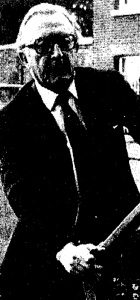
The cover photograph of a New York Times article, titled “Atlantic Allies at London Parlay Plan to Review Ties with Soviet,” published on January 1, 1980 by Pranay Gupte, of the United Kingdom’s Foreign Secretary, Peter Carrington, at the London meeting to discuss the West’s approach to the Soviet presence in Afghanistan.
On December 24, 1979, the Soviet Union invaded the northern sector of Afghanistan to assist the communist government, controlled by the People’s Democratic Party of Afghanistan,(PDPA), in retaining power and defeating various rebellious groups, who fought against the government due to religious oppression and other grievances against the government. The president of Afghanistan, Hafizullah Amin, was killed by Soviet special forces for no longer being seen as reliable after apprehending former president Noor Taraki. Former Vice President Babrak Karmal was implanted as president by the USSR within the same week of the invasion. Soviet intervention was authorized and guided by Premier Leonid Brezhnev. Only one year prior, in 1978, Prime Minister Mohammad Daoud was killed in a coup by the PDPA to realign Afghanistan with the Soviet Union, as Daoud had tried to improve relations with the United States and decrease dependency on the USSR. The newly instated PDPA had minimal to non-existent support from Afghans and was effectively a puppet government to maintain Soviet control and influence. The Soviet Union, however, did not concern itself with regional dynamics and only saw Afghanistan as important in the larger Cold War.
President Jimmy Carter, a staunch supporter of détente and committed towards the de-escalation of the Cold War, significantly shifted his rhetoric and policy upon learning of the Soviet’s crossing of the Afghan border, unlike in 1978. On January 23, 1980, he officially enumerated the Carter Doctrine in response to the Soviet presence in Afghanistan. It stated that the United States would use military force if its oil interests in the Persian Gulf were threatened, alluding to a guaranteed response if the Soviet Union attempted to interfere, which was a drastic shift from his previous approach to the Cold War. The USSR entered Afghanistan under the guidance of the Brezhnev Doctrine of 1968, espoused by the leader of the Soviet Union, Leonid Brezhnev, and was the Soviet counterpart to the Truman Doctrine. Specifically, Brezhnev classified a threat to a socialist country as one to the socialist world, and pledged intervention to uphold the spread of socialism and communism.
The article, titled “NUMBER PUT AT 30,000,” was published on December 31, 1979, one week after the Soviet incursion. There was no specific author, with the only information listed being “Special to the New York Times.” The piece was written in an overtly speculative tone, largely due to the lack of concrete information of the constantly evolving situation. Additionally, the United States was mentioned once in the entirety of the article, where “Zbigniew Brzezinski, President Carter’s national security advisor, said that the number of Soviet troops in Afghanistan had grown beyond the previous estimate of 25,000 to 30,000.” The author focused the majority of the article on the turmoil of the Afghan government, specifically the three recent presidents of Afghanistan, Karmal, Amin, and Noor Muhammad Taraki, the latter two of whom were dead. The author noted that Karmal persisted in his radio presence, calling for previous governmental staff under Amin “to report for reassignment. [But] if past Afghan coups are a guide, a number of the people who turn themselves in are likely to be killed or imprisoned.” The author further explained the Soviet Union’s preference for Taraki as the leader of Afghanistan, and its equal disdain for Amin, led to Amin’s death sentence and subsequent execution. They surmised through “various sources, including diplomats [and] Afghan exiles” that Amin’s removal was heavily influenced by Brezhnev, with no concrete and confirmative source. There was no critique of U.S. policy, with the Carter Doctrine coming a full month afterwards, and the London Conference convened the day following the publication of the report.
The situation in Afghanistan was chaotic and unclear, and the American perspective was clouded due to this state of affairs. In Gupte’s article, the Soviet incursion was described by the United States and its allies as “‘naked aggression’ and ‘flagrant violation of international law.’” Additionally, more military information had been unveiled in Drew Middleton’s “Soviet Phase 2: Consolidating Hold on Afghanistan” piece, also published on January 1, 1980. Middleton presented a dire situation in Afghanistan, where “fragmentary reports from Afghanistan [said] that Soviet troops…appear to [have taken] over the country’s main military air bases” in the previous couple days, and cited a rough figure of 50,000 Soviet soldiers in Afghanistan, a 20,000 troop increase from December 31.
Bibliography
The Editors of Encyclopaedia Britannica. “Soviet invasion of Afghanistan.” Britannica. Last modified May 11, 2020. https://www.britannica.com/event/Soviet-invasion-of-Afghanistan.
Glazer, Stephen G. “The Brezhnev Doctrine.” The International Lawyer 5, no. 1 (1971): 169-79. http://www.jstor.org/stable/40704652.
Gompert, David C., Hans Binnendijk, and Bonny Lin. “The Soviet Invasion of Afghanistan, 1979.” In Blinders, Blunders, and Wars: What America and China Can Learn, 129-38. N.p.: RAND, 2014. http://www.jstor.org/stable/10.7249/j.ctt1287m9t.18.
Gupte, Pranay B. “Atlantic Allies at London Parley Plan to Review Ties With Soviet.” The New York Times, January 1, 1980, 3.
Leffler, Melvyn P. For the Soul of Mankind. New York, United States of America: Hill and Wang, 2007.
Middleton, Drew. “Soviet Phase 2: Consolidating Hold on Afghanistan.” The New York Times (New York, United States of America), January 1, 1980. https://search-proquest-com.newman.richmond.edu/hnpnewyorktimes/docview/121180704/8024ABE509E546A5PQ/1?accountid=14731.
Saikal, Amin. “Islamism, the Iranian revolution, and the Soviet invasion of Afghanistan.”. In The Cambridge History of the Cold War, Vol. 3 edited by Melvyn P. Leffler and Odd Arne Westad, . New York: Cambridge University Press, 2010: 112-34. .
Special to The New York Times. “Number Put at 30,000.” The New York Times, December 31, 1979, A1, contd. A6.
United States Department of State. “Carter’s Foreign Policy.” Office of the Historian. https://history.state.gov/departmenthistory/short-history/carter.
Westad, Odd Arne. “Prelude to Invasion: The Soviet Union and the Afghan Communists, 1978-1979.” The International History Review 16, no. 1 (1994): 49-69. http://www.jstor.org/stable/40106851.
